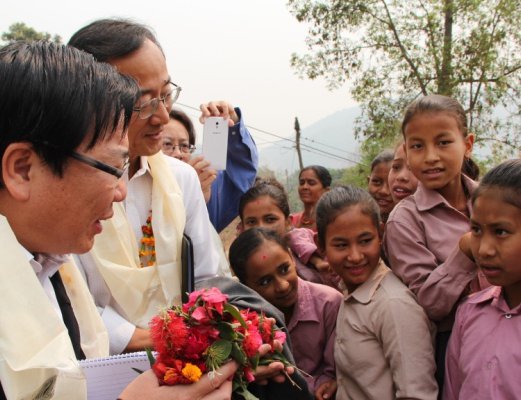
Asian Development Bank has said that the economic growth for South Asia is robust, with India taking the lead with over 7 percent growth, and Pakistan showing improvement in energy and investment in infrastructure. However, Nepal’s economy will remain sluggish.
Although the monsoon is better than that of the previous years, Nepal is yet to recover from last year’s economic disturbances. With the political deadlock continuing and no early solution in sight, the situation will only go from bad to worse.
Nepal’s 14th year National Plan targets a growth of over 6 percent in the coming three years. However, the existing conditions do not offer the prospects of realizing the target. Given the improvement in monsoon and increase in capital expenditure, one can expect a certain amount of progress. But given the present political trend, such progress is unlikely.
Growth in Asia and the Pacific’s developing economies for 2016 and 2017 will remain solid as firm performances from South Asia, East Asia and Southeast Asia help offset softness from the US economy, and near-term market shocks from the Brexit vote, says a new Asian Development Bank (ADB) report.
In a supplement to its Asian Development Outlook 2016 (ADO 2016) report, released last March, ADB now forecasts 2016 growth for the developing economies at 5.6%, below its previous projection of 5.7%. For 2017, growth is seen unchanged at 5.7%,
“Although the Brexit vote has affected developing Asia’s currency and stock markets, its impact on the real economy in the short term is expected to be small,” said Shang-Jin Wei, ADB’s Chief Economist. “However, in light of the tepid growth prospects in the major industrial economies, policy makers should remain vigilant and be prepared to respond to external shocks to ensure growth in the region remains robust.”
Growth in 2016 and 2017, the report notes, is led by South Asia, and India in particular, which continues to expand strongly, while the People’s Republic of China (PRC) is on track to meet earlier growth projections.
In East Asia, despite muted activity in Hong Kong, China and the Republic of Korea, growth forecasts are unchanged at 5.7% in 2016 and 5.6% in 2017, with the world’s second largest economy, the PRC, on track to meet projected growth of 6.5% in 2016 and 6.3% in 2017. To support its targets, the PRC government is expected to continue using fiscal and monetary stimulus measures.
South Asia, meanwhile, is expected to be the fastest growing sub region, led by India, whose economy has shrugged off global headwinds and is on track to meet ADB’s March fiscal year 2016 (year to March 2017) projected growth target of 7.4%, supported by brisk consumer spending and an uptick in the rural economy. In Pakistan, further improvements in energy supply, higher infrastructure investments, and an improved security environment will help push up growth in 2016 and 2017 the report said, while the Bangladesh economy will remain robust on the strength of its garments sector.
In Southeast Asia, growth projections for the sub region in 2016 and 2017 remain unchanged at 4.5% and 4.8%, with solid performances by most economies in the first half of 2016 driven by private consumption. The exception was Vietnam where the economy came under pressure from a worsening drought that caused a contraction in the agriculture sector.
Continued soft commodity prices and the recession in the Russian Federation have further dampened the growth outlook for Central Asia, with the earlier 2016 forecast of 2.1% trimmed to 1.7%, and 2017 cut to 2.7% from 2.8%.
The slump in revenues from hydrocarbon exports are affecting fiscal consolidation efforts in Azerbaijan, Kazakhstan, Turkmenistan and Uzbekistan, while lower remittances, particularly from the Russian Federation, continue to hurt domestic consumption in the sub region.
In the Pacific, growth for 2016 is expected to moderate to 3.9% in 2016 from 7.1% in 2015, with the Fijian economy reeling from Cyclone Winston. However there are some bright spots with stronger-than-expected tourism receipts aiding the Cook Islands and Samoa, while Vanuatu’s economy is being boosted by the rollout of post-cyclone reconstruction work and other major infrastructure projects.
The report now projects inflation for developing Asia to come in at 2.8% for 2016 and 3.0% for 2017—a 0.3 percentage point rise for each year from the previous forecasts. The rise is due largely to a recovery in oil and food prices. Oil prices rebounded from early-year lows and food prices rose nearly 9% in June 2016 from the year earlier, marking the fifth consecutive month the index has risen in value.

Keshab Poudel
Poudel is the editor of New Spotlight Magazine.
- IWMI: SoLAR Global Science-Policy Forum Conference
- Apr 25, 2024
- CLA: Samriddhi For Skill Development
- Apr 23, 2024
- ECONOMY: Growth At 3.3
- Apr 16, 2024
- DPM’s SHRESTHA’S CHINA VISIT High Profile, Low Key
- Apr 14, 2024
- Maha Kumbha In Barahkshetra: A Sacred Festival In Sacred Koshi (Kaushiki) River
- Apr 09, 2024
















